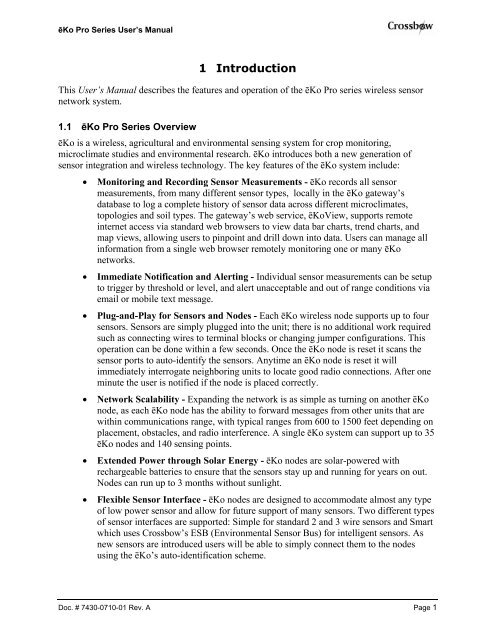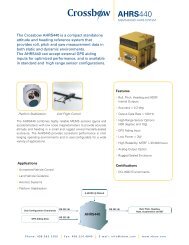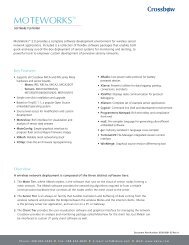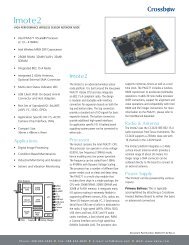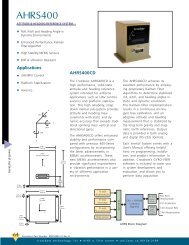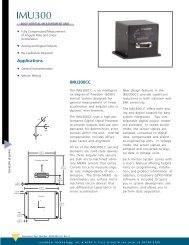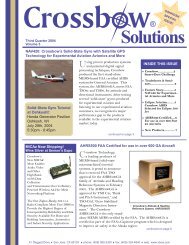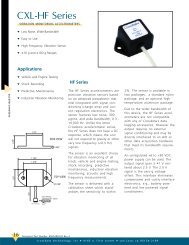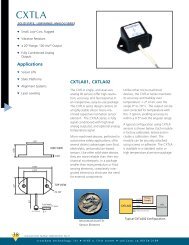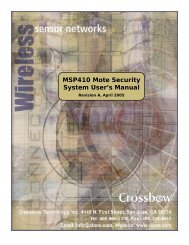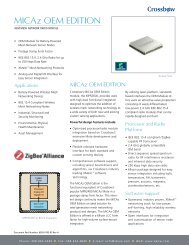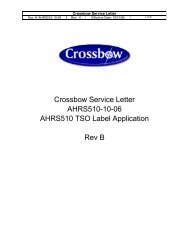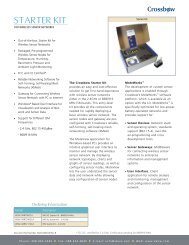ēKo Pro series User's Manual - Crossbow Technology
ēKo Pro series User's Manual - Crossbow Technology
ēKo Pro series User's Manual - Crossbow Technology
You also want an ePaper? Increase the reach of your titles
YUMPU automatically turns print PDFs into web optimized ePapers that Google loves.
<strong>ēKo</strong> <strong>Pro</strong> Series User’s <strong>Manual</strong><br />
1 Introduction<br />
This User’s <strong>Manual</strong> describes the features and operation of the <strong>ēKo</strong> <strong>Pro</strong> <strong>series</strong> wireless sensor<br />
network system.<br />
1.1 <strong>ēKo</strong> <strong>Pro</strong> Series Overview<br />
<strong>ēKo</strong> is a wireless, agricultural and environmental sensing system for crop monitoring,<br />
microclimate studies and environmental research. <strong>ēKo</strong> introduces both a new generation of<br />
sensor integration and wireless technology. The key features of the <strong>ēKo</strong> system include:<br />
• Monitoring and Recording Sensor Measurements - <strong>ēKo</strong> records all sensor<br />
measurements, from many different sensor types, locally in the <strong>ēKo</strong> gateway’s<br />
database to log a complete history of sensor data across different microclimates,<br />
topologies and soil types. The gateway’s web service, <strong>ēKo</strong>View, supports remote<br />
internet access via standard web browsers to view data bar charts, trend charts, and<br />
map views, allowing users to pinpoint and drill down into data. Users can manage all<br />
information from a single web browser remotely monitoring one or many <strong>ēKo</strong><br />
networks.<br />
• Immediate Notification and Alerting - Individual sensor measurements can be setup<br />
to trigger by threshold or level, and alert unacceptable and out of range conditions via<br />
email or mobile text message.<br />
• Plug-and-Play for Sensors and Nodes - Each <strong>ēKo</strong> wireless node supports up to four<br />
sensors. Sensors are simply plugged into the unit; there is no additional work required<br />
such as connecting wires to terminal blocks or changing jumper configurations. This<br />
operation can be done within a few seconds. Once the <strong>ēKo</strong> node is reset it scans the<br />
sensor ports to auto-identify the sensors. Anytime an <strong>ēKo</strong> node is reset it will<br />
immediately interrogate neighboring units to locate good radio connections. After one<br />
minute the user is notified if the node is placed correctly.<br />
• Network Scalability - Expanding the network is as simple as turning on another <strong>ēKo</strong><br />
node, as each <strong>ēKo</strong> node has the ability to forward messages from other units that are<br />
within communications range, with typical ranges from 600 to 1500 feet depending on<br />
placement, obstacles, and radio interference. A single <strong>ēKo</strong> system can support up to 35<br />
<strong>ēKo</strong> nodes and 140 sensing points.<br />
• Extended Power through Solar Energy - <strong>ēKo</strong> nodes are solar-powered with<br />
rechargeable batteries to ensure that the sensors stay up and running for years on out.<br />
Nodes can run up to 3 months without sunlight.<br />
• Flexible Sensor Interface - <strong>ēKo</strong> nodes are designed to accommodate almost any type<br />
of low power sensor and allow for future support of many sensors. Two different types<br />
of sensor interfaces are supported: Simple for standard 2 and 3 wire sensors and Smart<br />
which uses <strong>Crossbow</strong>’s ESB (Environmental Sensor Bus) for intelligent sensors. As<br />
new sensors are introduced users will be able to simply connect them to the nodes<br />
using the <strong>ēKo</strong>’s auto-identification scheme.<br />
Doc. # 7430-0710-01 Rev. A Page 1


